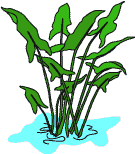 |
16. Water Quality - Ideal Levels
|
|
|
 |
Water Quality Pollutants and Toxins
In addition to pH and dissolved oxygen. monitor levels of these common pollutants and water quality parameters on a regular basis. Partial water changes will immediately, but temporarily, dilute toxic levels of the compounds listed in this chart. If problems persist, however, steps should be taken to eliminate the
source of the problem.
|
|
| Parameter/Toxin |
Level |
Description |
|
|
|
| Ammonia |
0ppm |
Ammonia is extremely toxic and should never read above 0ppm. Treat ammonia problems with Water Garden Cleaner ASF. Persistent ammonia indicates a high animal load and poor filtration. |
|
| Nitrite |
0ppm |
Consistent readings above 0ppm indicate lack of proper filtration or overpopulation of animals. Nitrite can be reduced with Aqua Bacta Aid and filtration. |
|
| Nitrate |
0ppm |
High nitrate causes excess algae growth and animal stress and should be 0ppm. Addition of submerged plants helps utilize nitrate. Water changes and de*Nitrate also lower nitrate. |
|
| Carbon Dioxide |
~ 5ppm |
Required by plants for photosynthesis, respiration by-product from fish. High carbon dioxide levels lower pH. Acceptable level is 5ppm. |
|
| Total Hardness (gH) |
80ppm |
Hardness is caused by increases in salts of calcium and magnesium and is an indication of soft or hard water. Hard water is usually accompanied by high pH. 80ppm is acceptable. |
|
| Chlorine/Chloramine |
0ppm |
Chlorine is deadly to all fish! ALWAYS dechlorinate all freshwater added to your pond. |
|
| Heavy Metals |
< .01ppm |
Heavy metals from run-off interfere with biochemical reactions in both plants and animals and should be less than .01ppm. Heavy pollution can eventually lead to death. Treat with activated carbon. |
|
| Phosphate |
0ppm |
Phosphates are introduced from fertilizer run-off and as a by-product of fish metabolism. High phosphates promote algae growth. Use Phosgard or do water changes. |
|
|
|
|
|
 |
|
Maintaining the proper pH is essential to the biological activity that will sustain life in your pond. The addition of rainwater, the availability of nutrients to plants and animals, photosynthesis and many other factors can alter the pH of your pond. Ideal pH is 7.0. Check your pH frequently and take remedial action if pH consistently falls outside the ideal range. |
|
| Cause/Symptoms |
|
Cause |
|
Remedy |
|
|
|
|
|
High pH - pond is alkaline
• fish stress and disease
• ammonia is more toxic
• gill damage
• poor plant growth
• inefficient biological filtration |
|
• lime contact and cement products with water
• may be caused by or result in excessive algae growth causing diurnal fluctuations in pH |
|
• remove all sources of high lime, partial water changes
• use Microbe-Lift pH Decreaser or pH-Ease Decrease
• take action to reduce algae
• see algae control section
|
|
Low pH - pond is too acid
• continued fish disease,
• stunted growth of submerged plants |
|
• plants remove salts causing water to become too soft
• peat and decomposing plants cause increase in humic acid
• fish waste buildup in water
• nitrate buildup in water |
|
• partial water changes
• use pH-Ease Increase
• add a plant filtering system to help absorb nitrates
• use products that reduce nitrates
• increase filtration |
|
|
 |
|
Oxygen is essential for a healthy pond. Bodies of standing water are rapidly depleted of essential oxygen and become what we notice as 'stagnant.' This unpleasant situation can be improved by moving inactive water by adding fountains, waterfalls, water features, and other systems. The addition of submerged plants and their photosynthetic activity will also increase available oxygen. Problems with oxygen can also occur when too much of the pond's surface is covered with plants and from overstocking fish.
|
| |
An excellent way to prevent oxygen depletion is the addition of advanced external trickle-type filtration. As pond water moves through the trickling medium it is replenished with oxygen as bacteria remove pollutants.
Overstocking of fish causes production of excess ammonia and nitrite. The bacteria that convert these wastes in ponds must utilize oxygen. As you add fish, the waste increases and the bacteria will increase to accomodate the load, which further increases the demand for oxygen. The advantage an external trickle filter has over other types of filtration is that the bacteria are cultured on a plastic matrix suspended in a tower with water trickling over it. This allows bacteria to constantly utilize oxygen from the air while continuously re-oxygenating the water to levels not attainable by other forms of filtration. Properly designed trickle filters eliminate oxygen depletion problems. |
|
|
 |
|
|
| Milaukee Dissolved Oxygen Test MIL1003 |
|
|
|
|
Show All Test Kits
|
 |
|
|




